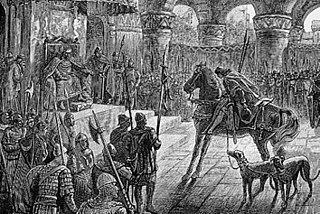
Mabon ap Modron is a prominent figure from Welsh and wider Brythonic literature and mythology, the son of Modron and a member of Arthur's war band. Both he and his mother were likely deities in origin, descending from a divine mother–son pair. He is often equated with the Demetian hero Pryderi fab Pwyll, and may be associated with the minor Arthurian character Mabon ab Mellt.

Gwyn ap Nudd is a Welsh mythological figure, the king of the Tylwyth Teg or "fair folk" and ruler of the Welsh Otherworld, Annwn, and whose name means “Gwyn, son of Nudd”. Described later on as a great warrior with a "blackened face", Gwyn is intimately associated with the otherworld in medieval Welsh literature, and is associated with the international tradition of the Wild Hunt.
Cú Roí mac Dáire is a king of Munster in the Ulster Cycle of Irish mythology. He is usually portrayed as a warrior with superhuman abilities and a master of disguise possessed of magical powers. His name probably means "hound of the plain/field", or more specifically, "hound of the battlefield". He is the son of Dáire mac Dedad, and thus belongs to the Clanna Dedad. However, T. F. O'Rahilly believed this to be artificial, stating that "Cú Roí and Dáire are ultimately one and the same".
Culhwch, in Welsh mythology, is the son of Cilydd son of Celyddon and Goleuddydd, a cousin of Arthur and the protagonist of the story Culhwch and Olwen. In this tale the etymology of Culhwch is explained as "sow run", but this is likely to be folk etymology. According to the narrative, Culhwch is born to his maddened mother Goleuddydd after she is frightened by a herd of swine. The swineherd finds Culhwch in the pigs' run, and takes him back to his father Cilydd. Culhwch is described as being "of gentle lineage".
In Welsh mythology, Olwen is the daughter of the giant Ysbaddaden and cousin of Goreu. She is the heroine of the story Culhwch and Olwen in the Mabinogion. Her father is fated to die if she ever marries, so when Culhwch comes to court her, he is given a series of immensely difficult tasks which he must complete before he can win her hand. With the help of his cousin King Arthur, Culhwch succeeds and the giant dies, allowing Olwen to marry her suitor.
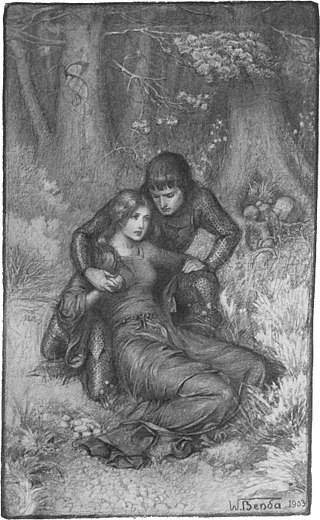
In the Matter of Britain, Igraine is the mother of King Arthur. Igraine is also known in Latin as Igerna, in Welsh as Eigr, in French as Ygraine, in Le Morte d'Arthur as Ygrayne—often modernised as Igraine or Igreine—and in Parzival as Arnive. She becomes the wife of Uther Pendragon, after the death of her first husband, Gorlois.

Culhwch and Olwen is a Welsh tale that survives in only two manuscripts about a hero connected with Arthur and his warriors: a complete version in the Red Book of Hergest, c. 1400, and a fragmented version in the White Book of Rhydderch, c. 1325. It is the longest of the surviving Welsh prose tales. Lady Charlotte Guest included this tale among those she collected under the title The Mabinogion.

Bedivere is one of the earliest characters to be featured in the legend of King Arthur, originally described in several Welsh texts as the one-handed great warrior named Bedwyr Bedrydant. Arthurian chivalric romances, inspired by his portrayal in the chronicle Historia Regum Britanniae, portray Bedivere as a Knight of the Round Table of King Arthur who serves as Arthur's marshal and is frequently associated with his brother Lucan and his cousin Griflet as well as with Kay. In the English versions, Bedivere notably assumes Griflet's hitherto traditional role from French romances as the one who eventually returns Excalibur to the Lady of the Lake after Arthur's last battle.
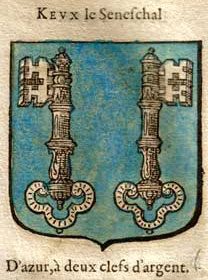
In Arthurian legend, Kay is King Arthur's foster brother and later seneschal, as well as one of the first Knights of the Round Table. In later literature he is known for his acid tongue and bullying, boorish behaviour, but in earlier accounts he was one of Arthur's premier warriors. Along with Bedivere, with whom he is frequently associated, Kay is one of the earliest characters associated with Arthur. Kay's father is called Ector in later literature, but the Welsh accounts name him as Cynyr Ceinfarfog.

Welsh mythology consists of both folk traditions developed in Wales, and traditions developed by the Celtic Britons elsewhere before the end of the first millennium. As in most of the predominantly oral societies Celtic mythology and history were recorded orally by specialists such as druids. This oral record has been lost or altered as a result of outside contact and invasion over the years. Much of this altered mythology and history is preserved in medieval Welsh manuscripts, which include the Red Book of Hergest, the White Book of Rhydderch, the Book of Aneirin and the Book of Taliesin. Other works connected to Welsh mythology include the ninth-century Latin historical compilation Historia Brittonum and Geoffrey of Monmouth's twelfth-century Latin chronicle Historia Regum Britanniae, as well as later folklore, such as the materials collected in The Welsh Fairy Book by William Jenkyn Thomas (1908).
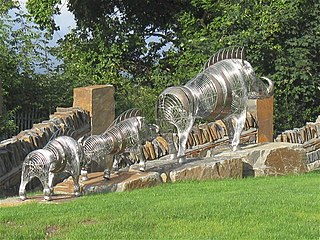
Twrch Trwyth, is a fabulous wild boar from the Legend of King Arthur, of which a richly elaborate account of its hunt described in the Welsh prose romance Culhwch and Olwen, probably written around 1100.
Goleuddydd, in the Middle Welsh prose tale Culhwch ac Olwen, is the daughter of Amlawdd Wledig, and is desired by Cilydd, who marries her. She becomes pregnant with his child, but becomes mad and turns to wandering the countryside. When she is near to giving birth, her senses return, and she takes shelter with a swineherd. Frightened by the pigs, she gives birth to a boy, apparently in a pig run. The swineherd takes the baby away to be baptised as Culhwch; he becomes the protagonist of Culhwch and Olwen.
Menw, son of Three-Cries, is a hero and shapeshifter in early Welsh literature, an "Enchanted Knight" of King Arthur at his court at Celliwig. He appears most prominently in the early Arthurian tale Culhwch and Olwen, in which he is handpicked among Arthur's warriors to accompany Culhwch on his quest to win Olwen. An "Enchanter Knight" of Arthur's court, he learned one of the Three Enchantments from Uther Pendragon. He is ascribed a son named Anynnawg.
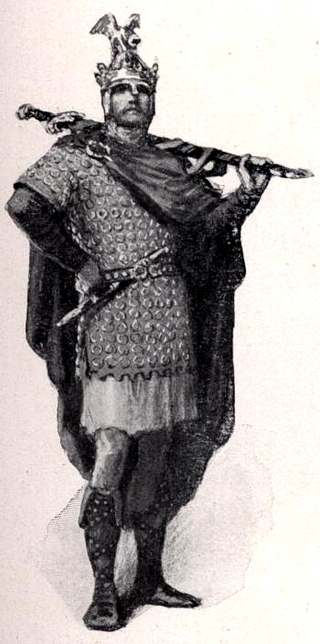
King Arthur's family grew throughout the centuries with King Arthur's legend. Many of the legendary members of this mythical king's family became leading characters of mythical tales in their own right.
Gwrhyr Gwalstawd Ieithoedd; "Gwrhyr, Interpreter of Languages" is a hero and shapeshifter of early Welsh literature and mythology and a warrior of King Arthur's court at Celliwig. He appears most prominently in the early Arthurian tale Culhwch and Olwen, in which he is handpicked among Arthur's knights to accompany Culhwch on his quest to win Olwen.
Glewlwyd Gafaelfawr is a hero, warrior, and porter in tradition and Arthurian mythology, in which he appears as a knight in Arthur's retinue and chief gatekeeper of his court. He is one of the earliest characters to be associated with Arthur and appears in a number of texts, including Culhwch ac Olwen, Geraint fab Erbin, Iarlles y Ffynnon, Pa Gur yv y Porthur and the Welsh Triads.
Giants feature prominently in Welsh folklore and mythology. Among the most notable are Bendigeidfran fab Llyr, a mythological king of Britain during the Second Branch of the Mabinogi, Idris Gawr of Cader Idris, and Ysbaddaden Bencawr, the chief antagonist of the early Arthurian tale How Culhwch won Olwen. Both Arthur and Gwalchmai fab Gwyar feature prominently as giant-slayers in Welsh tradition.
Goreu fab Custennin is a hero of Welsh and early Arthurian mythology, the son of Custennin, and cousin to Arthur, Culhwch and Saint Illtud through their grandfather Amlawdd Wledig. He is a significant character in the Middle Welsh Arthurian tale Culhwch and Olwen, and also appears in a number of other medieval texts. His name may be derived from Gorneu; "of Cornwall."
In the earliest prose stories in Britain in the Mabinogi, the Adar Rhiannon; "birds of Rhiannon", are specifically three magical birds, whose song can "wake the dead and lull the living to sleep". They also have a non-rational effect on space as they can be remote but seem very near. They are connected with Rhiannon the Queen of Dyfed who is thought to be a British euhemerized horse goddess, so part of Welsh mythology. The Adar Rhiannon were demanded by the giant Ysbaddaden Bencawr as a marriage task for Culhwch to complete. The giant wanted the Birds to soothe him as he faced his last night of life, prophesied as the consequence of his daughter's wedding.
Amlawdd Wledig was a legendary king of sub-Roman Britain. The Welsh title [G]wledig, archaically Gwledic or Guletic and Latinised Guleticus, is defined as follows: "lord, king, prince, ruler; term applied to a number of early British rulers and princes who were prominent in the defence of Britain about the time of the Roman withdrawal; (possibly) commander of the native militia ".









